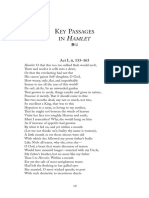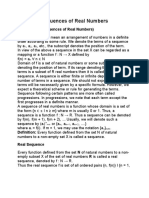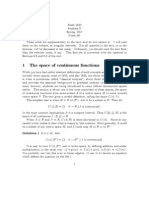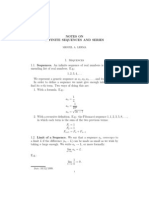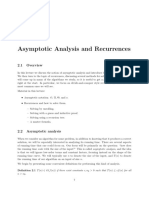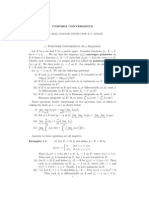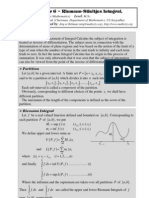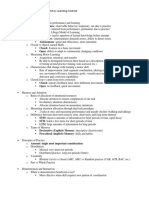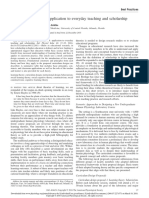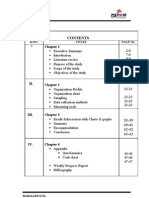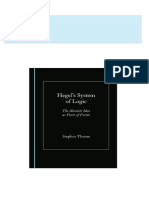Sequences and Limit of Sequences: 4.1 Sequences: Basic de Nitions
Sequences and Limit of Sequences: 4.1 Sequences: Basic de Nitions
Uploaded by
Himraj BachooCopyright:
Available Formats
Sequences and Limit of Sequences: 4.1 Sequences: Basic de Nitions
Sequences and Limit of Sequences: 4.1 Sequences: Basic de Nitions
Uploaded by
Himraj BachooOriginal Description:
Original Title
Copyright
Available Formats
Share this document
Did you find this document useful?
Is this content inappropriate?
Copyright:
Available Formats
Sequences and Limit of Sequences: 4.1 Sequences: Basic de Nitions
Sequences and Limit of Sequences: 4.1 Sequences: Basic de Nitions
Uploaded by
Himraj BachooCopyright:
Available Formats
Chapter 4
Sequences and Limit of
Sequences
4.1 Sequences: Basic Denitions
Denition 278 (sequence) A sequence is a function whose domain is a subset
of the form
: Z : : _ :
0
for some :
0
Z
The elements or the terms of the sequence, usually denoted r
n
will be of the
form: r
n
= ) (:). If the terms of a sequence are denoted r
n
, then the sequence
is denoted (r
n
) or r
n
. We can think of a sequence as a list of numbers. In this
case, a sequence will look like: r
n
= r
1
, r
2
, r
3
, .... The starting point, :
0
is
usually 1 but it does not have to be. However, it is understood that whatever
the starting point is, the elements r
n
should be dened for any : _ :
0
. For
example, if the general term of a sequence is r
n
=
2:
: 4
, then, we must have
:
0
_ 5.
A sequence can be given dierent ways.
1. List the elements. For example,
_
1
2
,
2
3
,
3
4
, ...
_
. From the elements listed,
the pattern should be clear.
2. Give a formula to generate the terms. For example, r
n
= (1)
n
2
n
:!
. If
the starting point is not specied, we use the smallest value of : which
will work.
3. A sequence can be given recursively. The starting value of the sequence
is given. Then, a formula to generate the :
th
term from one or more
103
104 CHAPTER 4. SEQUENCES AND LIMIT OF SEQUENCES
previous terms. For example, we could dene a sequence by giving:
r
1
= 2
r
n+1
=
1
2
(r
n
+ 6)
Another example is the Fibonacci sequence dened by:
r
1
= 1, r
2
= 1
r
n
= r
n1
+ r
n2
for : _ 3
Like a function, a sequence can be plotted. However, since the domain is a
subset of Z, the plot will consist of dots instead of a continuous curve.
Since a sequence is dened as a function. everything we dened for functions
(bounds, supremum, inmum, ...) also applies to sequences. We restate those
denitions for convenience.
Denition 279 (Bounded Sequence) As sequence (r
n
) is said to be bounded
above if its range is bounded above. It is bounded below if its range is bounded be-
low. It is bounded if its range is bounded. If the domain of (r
n
) is : Z : : _ / for some integer /
then the above denition simply state that the set r
n
: : _ / must be bounded
above, below or both.
Denition 280 (One-to-one Sequences) A sequence (r
n
) is said to be one-
to-one if whenever : ,= : then r
n
,= r
m
.
Denition 281 (Monotone Sequences) Let (r
n
) be a sequence.
1. (r
n
) is said to be increasing if r
n
_ r
n+1
for every : in the domain of the
sequence. If we have r
n
< r
n+1
, we say the sequence is strictly increasing.
2. (r
n
) is said to be decreasing if r
n
_ r
n+1
for every : in the domain of
the sequence.
3. A sequence that is either increasing or decreasing is said to be monotone.
If it is either strictly increasing or strictly decreasing, we say it is strictly
monotone.
Denition 282 (constant) (r
n
) is constant if r
n+1
= r
n
\:. (r
n
) is eventu-
ally constant if r
n+1
= r
n
\: for some positive integer .
Denition 283 (Periodic) (r
n
) is periodic if j Z
+
such that \:, r
n+p
=
r
n
.
Sometimes, when studying at a sequence, it is useful to look only at some
of its terms, not all of them. For example, we could take every other term. We
could also take some of the terms at random. More specically, given a sequence
a
n
= a
1
, a
2
, a
3
, ..., we can dene a new sequence /
k
= a
n
k
, made from
4.2. LIMIT OF A SEQUENCE: DEFINITIONS 105
some of the terms of a
n
as follows: Let :
1
denote the index of the rst element
of a
n
we select and dene /
1
= a
n1
.. Let :
2
denote the index of the second
element of a
n
we select and dene /
2
= a
n2
. In general, let :
k
denotes the
index of the /
th
element of a
n
we select and dene /
k
= a
n
k
. In doing so,
note that :
k
_ / (as long as : _ 1 which we can achieve by renumbering).
Denition 284 (subsequence) The sequence /
k
as dened above is called a
subsequence of a
n
. Simply speaking, a subsequence is a sequence which only
contains some of the terms of the original sequence. However, it still contains
an innite amount of terms, in other words, it does not stop.
Another way of dening a subsequence is given below.
Denition 285 (subsequence) A subsequence of a sequence (r
n
) is a se-
quence of the form
_
r
'(n)
_
where , : N N is a strictly increasing function.
For example, (r
2n
) is a subsequence of (r
n
), in this case, ,(:) = 2:. (r
2n+1
)
is another subsequence, in this case ,(:) = 2: + 1.
Example 286 Given a sequence (r
n
)
1. (r
2n
) is a subsequence of (r
n
), in this case, ,(:) = 2:.
2. (r
2n+1
) is another subsequence, in this case ,(:) = 2: + 1.
4.2 Limit of a Sequence: Denitions
4.2.1 The Concepts of Eventually and Frequently
Denition 287 (Eventually and frequently) Let (r
n
) be a sequence and
o _ R.
1. (r
n
) is eventually in o if there exists 0 such that : _ ==r
n
o.
2. (r
n
) is frequently in o if r
n
o for innitely many values of :.
Examples:
(r
n
) where r
n
= (1)
n
is frequently in the set 1 and well as frequently
in the set 1.
(r
n
) where r
n
=
_
1 if 1 _ : _ 20
0 if : 20
is eventually in the set 0.
(r
n
) where r
n
= ln: is eventually is the set [2, ).
The following are simple observations regarding these two notions:
If a sequence is in a set, then it is eventually in the set.
106 CHAPTER 4. SEQUENCES AND LIMIT OF SEQUENCES
If a sequence is eventually in a set, then it is frequently in the set.
(r
n
) is eventually in o if and only if it is not frequently in R o.
(r
n
) is frequently in o if and only if it is not eventually in R o.
The following is an important theorem regarding subsequences.
Theorem 288 Let (r
n
) be a sequence and o _ R. The following are equivalent:
1. (r
n
) is frequently in o.
2. (r
n
) has a subsequence in o.
Proof. We prove both directions.
1. (1 ==2). Since (r
n
) is frequently in o, (r
n
) o for innitely many :.
Let :
i
be the i
th
index of (r
n
) for which (r
n
) o. Then the sequence (j
n
)
where j
i
= r
ni
is both a subsequence of (r
n
) and is in o.
2. (2 ==1). Since a subsequence of (r
n
) contains an innite number of
terms of (r
n
), the result follows.
4.2.2 Denitions of Limits
In the following, we assume that (r
n
) is a sequence of real numbers and 1 is an
extended real number. In this section, We wish to investigate the behavior of
r
n
as : gets arbitrarily large, in other words as : . This is called nding
the limit of r
n
as : approaches , it is denoted lim
n!1
r
n
. We want to know if
the values of r
n
keep on changing as : , or if they seem to get closer to
some number. Several things can happen. As : , r
n
could get arbitrarily
large (or small), in other words, r
n
. Another possibility is that the
values of r
n
will get closer and closer to some number we will call 1. But, it is
also possible that the values of r
n
will keep on changing forever. If we allow 1
to be an extended real number, then the rst two cases can be summarized in
lim
n!1
r
n
= 1. We now give a more precise denition of limits as well as partial
limits.
Denition 289 (Limit) lim
n!1
r
n
= 1 if for every neighborhood l of 1, (r
n
)
is eventually in l. In this case, we write one of the following:
lim
n!1
r
n
= 1
limr
n
= 1
r
n
1 as :
r
n
1
4.2. LIMIT OF A SEQUENCE: DEFINITIONS 107
If 1 is a real number, we say that (r
n
) converges to 1 or that 1 is a nite
limit for (r
n
). Otherwise, we sat that (r
n
) diverges. Note that (r
n
) may diverge
for two reasons. The rst one is if 1 = , in this case, we say that (r
n
) has
an innite limit. The second is if (r
n
) has no limit at all.
Denition 290 (Partial limit) 1 is a partial limit of (r
n
) if for every neigh-
borhood l of 1, (r
n
) is frequently in l.
We now give equivalent conditions for a sequence to have a limit and a
partial limit. In each case, we consider whether the limit (partial limit) is nite
or innite.
Theorem 291 (Finite Limit) Let (r
n
) be a sequence, and 1 R. The fol-
lowing are equivalent:
1. 1 is a limit of (r
n
) in other words lim
n!1
r
n
= 1.
2. \c 0, (r
n
) is eventually in (1 c, 1 + c).
3. \c 0, 0 such that : _ ==r
n
(1 c, 1 + c).
4. \c 0, 0 such that : _ ==[r
n
1[ < c.
Proof. We prove (1 ==2 ==3 ==4 ==1).
1. (1 ==2). Let c 0 be given. Then (1 c, 1 + c) is a neighborhood of
1. Thus, if lim
n!1
r
n
= 1 it follows by denition that (r
n
) is eventually in
(1 c, 1 + c).
2. (2 ==3). This is the denition of eventually.
3. (3 ==4). r
n
(1 c, 1 + c) ==1c < r
n
< 1+c ==c < r
n
1 <
c ==[r
n
1[ < c.
4. (4 ==1). We need to show that (r
n
) is eventually in l where l is any
neighborhood of 1. If l is any neighborhood of 1, then by denition, l
contains (1 c, 1 + c) for some c 0. We can nd 0 such that
: _ ==[r
n
1[ < c
== c < r
n
1 < c
== 1 c < r
n
< 1 + c
== r
n
(1 c, 1 + c)
== r
n
l
Thus r
n
is eventually in l. Since l was arbitrary, the result follows.
108 CHAPTER 4. SEQUENCES AND LIMIT OF SEQUENCES
Remark 292 Part 4 of theorem 291 is known as the c c denition of the
limit.
Theorem 293 (Finite Partial Limit) Let (r
n
) be a sequence, and 1 R.
The following are equivalent:
1. 1 is a partial limit of (r
n
).
2. \c 0, (r
n
) is frequently in (1 c, 1 + c).
3. \c 0, r
n
(1 c, 1 + c) for innitely many :.
4. \c 0,[r
n
1[ < c for innitely many :.
Proof. See problems
Theorem 294 (Innite Limit) Let (r
n
) be a sequence, and 1 = (the case
1 = is similar and left to the reader). The following are equivalent:
1. is a limit of (r
n
) in other words lim
n!1
r
n
=
2. \' 0, (r
n
) is eventually in (', ).
3. \' 0, 0 such that : _ ==r
n
(', ).
4. \' 0, 0 such that : _ ==r
n
'
Proof. See problems
Theorem 295 (Innite Partial Limit) Let (r
n
) be a sequence, and 1 =
(the case 1 = is similar and left to the reader). The following are equiva-
lent:
1. is a partial limit of (r
n
).
2. \' 0, (r
n
) is frequently in (', ).
3. \' 0, r
n
(', ) for innitely many :.
4. \' 0, r
n
' for innitely many :.
5. (r
n
) is unbounded above.
Proof. See problems
4.2. LIMIT OF A SEQUENCE: DEFINITIONS 109
4.2.3 Examples
Before we look at examples and elementary theorems, let us make some remarks.
[r
n
1[ simply represents the distance between r
n
and 1. If we think of c
as a very small quantity, then the above denition says that we can make
the distance between r
n
and 1 as small as we want, simply by taking :
large enough . In fact, no matter how small c is, we can make the distance
smaller. In essence, this is saying that if : is large enough, r
n
and 1
become identical. Think of this as a game between two persons. The
other person gives you a value for c, that it the other person tells you how
close he or she wants r
n
to be from 1. You must be able to nd such
that if : _ , r
n
will be within the prescribed distance. Not only r
n
, but
also all the terms after r
n
will be within the prescribed distance.
Graphically, if we draw the horizontal lines j = 1+c and j = 1c, then
saying : _ = [r
n
1[ < c means that all the values of r
n
will fall
within the region between the two lines whenever : _ .
It should be clear to the reader that to prove the limit is 1, c is arbitrary.
Given any c, the reader must prove the number in the denition can
be found. Usually, will depend on c. We now look at some examples to
see how this is done.
Example 296 Let (r
n
) be such that r
n
= c, for some constant c. Show that
r
n
c.
We need to show that for any c 0, (r
n
) is eventually in (c c, c + c). Since
r
n
= c for any :, (r
n
) is always in c _ (c c, c + c) for any c 0. Hence,
(r
n
) is eventually in (c c, c + c).
Example 297 This example is similar to the previous one, the dierence is
that (r
n
) is eventually constant, that is there exists 0 such that r
n
= c
whenever : _ . Again, show that r
n
c.
The proof is similar. Here, we have that (r
n
) is eventually in c _ (c c, c + c).
Example 298 Let (r
n
) be such that r
n
= (1)
n
. Prove that (r
n
) does not
have a limit (nite or innite) but has two partial limits: 1 and 1.
First, we prove that is not a limit of (r
n
). We can nd ' 0 such
that (r
n
) is not eventually in (', ). Any number ' 1 will do.
Next, we prove that is not a limit of (r
n
).We can nd ' < 0 such
that (r
n
) is not eventually in (, '). Any number ' < 1 will do.
Next, we prove that no real number can be a limit of (r
n
). We note that
r
n
only has two values, 1 and 1. For a real number r to be a limit of
(r
n
), both 1 and 1 would have to be eventually in (r c, r + c), for any
c 0. Clearly, if c =
1
2
, this cannot happen, no matter what r is. So, no
real number can be a limit of (r
n
).
110 CHAPTER 4. SEQUENCES AND LIMIT OF SEQUENCES
Next, we prove that 1 is a partial limit. We need to prove that (r
n
) is
frequently in (1 c, 1 + c), for any c 0. By theorem 288, it is enough
to show (r
n
) has a subsequence in (1 c, 1 + c), for any c 0. The
subsequence (r
2n
) is in 1 _ (1 c, 1 + c), for any c 0. The result
follows.
Finally, we prove that 1 is a partial limit. This is similar. We simply
note that the subsequence (r
2n1
) is in 1.
Example 299 Let (r
n
) be such that r
n
= :. Prove that r
n
. We need to
show that for any ' 0, there exists 0 such that : _ ==r
n
'. We
want r
n
'. This will happen when : ' (since r
n
= :). So, we see that
if is any integer greater than ', we will have : ' == r
n
'. Hence,
the result.
Example 300 Let (r
n
) be such that r
n
= :
2
. Prove that r
n
. We need
to show that for any ' 0, there exists 0 such that : _ ==r
n
'.
We want r
n
'. This will happen when :
2
' (since r
n
= :
2
), that is
when :
_
'. So, we see that if is any integer greater than
_
', we will
have : ' ==r
n
'. Hence, the result.
Example 301 Let (r
n
) be such that r
n
= (1)
n
:
2
. Prove that (r
n
) has no
limit and that are partial limits.
1. First, we see why neither nor can be limits of (r
n
). (r
n
) cannot
be eventually in (', ) for any number ' 0 because if r
n
(', ),
r
n+1
, (', ). For the same reason, (r
n
) cannot be eventually in
(, ') for any number ' < 0.
2. Then, we see why a real number r cannot be a limit for (r
n
). Let r R.
For r to be a limit of this sequence, (1)
n
:
2
has to be eventually in
(r c, r + c) for any c 0. We consider several cases.
r = 0. [r
n
[ increases without bounds, so r
n
will eventually get out of
any interval of the form (c, c).
r ,= 0. Let c =
[r[
2
. If r
n
is in (r c, r + c) then r
n+1
cannot be
there (why?)
3. Finally, we see why and are partial limits of (r
n
). The subsequence
(r
2n
) is eventually (', ) for any number ' 0 thus (r
n
) is frequently
in (', ) for any number ' 0. This means that is a partial limit
of (r
n
). Similarly, the subsequence (r
2n+1
) is eventually in (, ') for
any number ' < 0. This means that is a partial limit of (r
n
).
Example 302 Show that the sequence whose general term is r
n
=
1
:
converges
to 0.
4.2. LIMIT OF A SEQUENCE: DEFINITIONS 111
Given c 0, we need to nd such that : _ =
1
:
0
< c. To do this,
we usually start with what we want, i.e.
1
:
0
< c, and we try to nd the
condition : has to satisfy for it to happen.
1
:
0
< c =
1
:
< c
=
1
:
< c
=:
1
c
So, we see that if =
1
c
, then : _ =
1
:
0
< c.
Example 303 Show that the sequence whose general term is r
n
=
1
:
2
converges
to 0.
Given c 0, we need to nd such that : _ =
1
:
2
0
< c. To do this,
we usually start with what we want, i.e.
1
:
2
0
< c, and we try to nd the
condition : has to satisfy for it to happen.
1
:
2
0
< c =
1
:
2
< c
=
1
:
2
< c
=:
2
1
c
=:
1
_
c
or : <
1
_
c
Since : is a natural number, we only retain :
1
_
c
. So, we see that if =
1
_
c
,
then : _ =
1
:
0
< c.
Example 304 Same example as above, using a slightly dierent approach.
When we had
1
:
2
< c. We could have noticed that if : 1 we have
1
:
2
<
1
:
.
So, if we make
1
:
< c then what we need,
1
:
2
< c will also happen. We can
make
1
:
< c simply by taking :
1
c
, it will follow that
1
:
2
0
< c. This time,
we nd that =
1
c
works.
112 CHAPTER 4. SEQUENCES AND LIMIT OF SEQUENCES
Remark 305 It seems that if we do the same problem dierent ways, we nd a
dierent solution. We really dont. When we nd , the only thing we guarantee
is that if : _ , then [r
n
1[ < c. It might also be true if : is slightly less
than . In other words, we are not nding the smallest that will work. If we
use approximations like in example 304 , we may not get the best estimate for
.
Remark 306 The idea is the following. Forget mathematics for a second (just
a second). Imagine you are driving on a dirt road and you come to a bridge.
You are not sure if the bridge can withstand the weight of your car. If ahead of
you is a vehicle you know to be heavier than yours which just cleared the bridge,
then you know your vehicle can clear the bridge as well.
Remark 307 The above example illustrates a general technique to nd given
c. In general, the general term of the sequence is too complicated for us to be
able to solve for :. If we call r
n
the general term of the sequence, we do the
following: Start with [r
n
1[ and simplify it as much as possible. We get an
expression involving :, call it 1
1
(:). If we still cannot solve for : in 1
1
(:) < c,
we try to nd an upper bounds of [r
n
1[, call it 1
2
(:) for which we can solve
1
2
(:) < c. The result will follow. Since [r
n
1[ = 1
1
(:) < 1
2
(:), if we can
have 1
2
(:) < c, we will also have [r
n
1[ < c. Obviously, 1
2
(:) has to be
small enough so we can make it as small as we want. We illustrate this with
the next example.
Example 308 Show that the sequence r
n
whose general term is r
n
=
2: 1
3: + 2
converges to
2
3
.
Again, as before, we look at what we need, and see if we can derive the condition
: must satisfy.
2: 1
3: + 2
2
3
< c ==
6: 3 6: 7
3 (3: + 2)
==
10
3 (3: + 2)
< c
Though here we could solve for :, we can also use an upper bound instead. We
notice that
10
3 (3: + 2)
=
10
9: + 6
<
10
9:
Thus, if we make
10
9:
< c, it will follow that
2: 1
3: + 2
2
3
< c. The former
happens when :
10
9c
. So, given c 0, :
10
9c
==
2: 1
3: + 2
2
3
< c this
proves that lim
2: 1
3: + 2
=
2
3
.
4.2. LIMIT OF A SEQUENCE: DEFINITIONS 113
Example 309 Prove that lim
__
: + 1
_
:
_
= 0.
Again, as before, we look at what we need, and see if we can derive the condition
: must satisfy.
__
: + 1
_
:
_
0
< c ==
__
: + 1
_
:
_ __
: + 1 +
_
:
_
_
: + 1 +
_
:
< c
We work on the left side of the inequality and nd an upper bound.
__
: + 1
_
:
_ __
: + 1 +
_
:
_
_
: + 1 +
_
:
=
1
_
: + 1 +
_
:
<
1
2
_
:
So, if we make
1
2
_
:
< c, we will have what we need, that is
_
: + 1
_
:
< c.
The former happens when
_
:
1
2c
or :
1
4c
2
(since : 0). Now, we see
that given c 0, if :
1
4c
2
then
__
: + 1
_
:
_
0
< c thus proving that
lim
__
: + 1
_
:
_
= 0.
4.2.4 Exercises
1. Let r
n
= 3 +
1
:
. Prove that r
n
3.
2. Let r
n
= 3 +
2
:
. Prove that r
n
3.
3. Let r
n
=
1
:
for : N. If r R : r ,= 0, prove that r is not a partial limit
of (r
n
).
4. Let r
n
=
_
_
_
(1)
n
:
3
if : is a multiple of 3
0 if : is one more than a multiple of 3
4 if : is two more than a multiple of 3
. Prove
that the partial limits of (r
n
) are , , 0, 4.
5. Let r
n
=
3 + 2:
5 + :
. Prove that r
n
2.
6. Let r
n
=
_
_
1
2
n
if : = 2/
1
:
2
+ 1
if : = 2/ + 1
for any integer /. Prove that r
n
0.
7. Let r
n
=
:
2
+ 3: + 1
2:
2
+ : + 4
. Prove that r
n
1
2
.
8. Explain and justify the following observations made in the notes:
114 CHAPTER 4. SEQUENCES AND LIMIT OF SEQUENCES
(a) If a sequence is in a set, then it is eventually in the set.
(b) If a sequence is eventually in a set, then it is frequently in the set.
(c) (r
n
) is eventually in o if and only if it is not frequently in R o.
(d) (r
n
) is frequently in o if and only if it is not eventually in R o.
9. Prove theorem 288.
10. Prove theorem 293.
11. Prove theorem 294.
12. Prove theorem 295.
4.3. LIMIT OF A SEQUENCE: THEOREMS 115
4.3 Limit of a Sequence: Theorems
These theorems fall in two categories. The rst category deals with ways to
combine sequences. Like numbers, sequences can be added, multiplied, divided,
... Theorems from this category deal with the ways sequences can be combined
and how the limit of the result can be obtained. If a sequence can be written
as the combination of several "simpler" sequences, the idea is that it should be
easier ti nd the limit of the "simpler" sequences. These theorems allow us to
write a limit in terms of easier limits. however, we still have limits to evaluate.
The second category of theorems deal with specic sequences and techniques
applied to them. Usually, computing the limit of a sequence involves using
theorems from both categories.
4.3.1 Limit Properties
We begin with a few technical theorems. They do not play an important role in
computing limits, but they play a role in proving certain results about limits.
Theorem 310 Let r be a number such that \c 0, [r[ < c, then r = 0.
Proof. See problems at the end of the section.
Theorem 311 If a sequence converges, then its limit is unique.
Proof. We do a proof by contradiction. Assume that a
n
1
1
and a
n
1
2
.
Given c 0 choose
1
such that : _
1
== [a
n
1
1
[ <
c
2
. Similarly, choose
2
such that : _
2
== [a
n
1
2
[ <
c
2
. Let = max (
1
,
2
). If : _ ,
then
[1
1
1
2
[ = [1
1
a
n
+ a
n
1
2
[
_ [a
n
1
1
[ +[a
n
1
2
[
<
c
2
+
c
2
= c
By theorem 310 , it follows that 1
1
1
2
= 0, that is 1
1
= 1
2
.
Theorem 312 If a sequence converges, then it is bounded, that is there exists
a number ' 0 such that [a
n
[ _ ' for all :.
Proof. Choose such that : _ ==[a
n
1[ < 1. By the triangle inequality,
we have
[a
n
[ [1[ _ [a
n
1[
< 1
Thus, if : _ , [a
n
[ < 1 + [1[. Let '
1
= max ([a
1
[ , [a
2
[ , ..., [a
N
[). Let ' =
max ('
1
, 1 +[1[). Then, clearly, [a
n
[ < '
116 CHAPTER 4. SEQUENCES AND LIMIT OF SEQUENCES
Theorem 313 If a sequence converges, then \c 0 : :, : _ ==
[a
n
a
m
[ < c
Proof. Given c 0, we can choose such that :, : _ == [a
n
1[ <
c
2
and [a
m
1[ <
c
2
. Now,
[a
n
a
m
[ = [a
n
1 + 1 a
m
[
= [(a
n
1) (a
m
1)[
_ [(a
n
1)[ +[a
m
1[ by the triangle inequality
<
c
2
+
c
2
= c
The above theorem simply says that if a sequence converges, then the dif-
ference between any two terms gets smaller and smaller. It should also be clear
to the reader that if a
n
1, then so does a
n+k
where / is any natural number.
The above theorem can be used to prove that a sequence does not converge
by proving that the dierence between two of its terms does not get smaller and
smaller.
Example 314 Find limcos :
We suspect the sequence diverges, as its values will oscillate between -1 and
1 . We can actually prove it using theorem 313. We notice that for any :,
[cos 2: cos ((2: + 1) )[ = 2. For the sequence to converge, this dierence
should approach 0. Hence, the sequence diverges.
Theorem 315 Suppose that (a
n
) converges. Then, any subsequence (a
n
k
) also
converges and has the same limit.
Proof. Suppose that a
n
1. Let /
k
= a
n
k
be a subsequence. We need to prove
that given c 0, there exists such that / _ == [/
k
1[ < c. Let c 0
be given. Choose such that :
k
_ == [a
n
k
1[ < c. Now, if / _ , then
:
k
_ therefore
[/
k
1[ = [a
n
k
1[
< c
This theorem is often used to show that a given sequence diverges. To do so,
it is enough to nd two subsequences which do not converge to the same limit.
Alternatively, once can nd a subsequence which diverges.
Example 316 Study the convergence of cos :
The subsequence cos 2: converges to 1, while the subsequence cos (2: + 1)
converges to 1. Thus, cos 2: must diverge.
In the next two sections, we look at theorems which give us more tools to
compute limits.
4.3. LIMIT OF A SEQUENCE: THEOREMS 117
4.3.2 Limit Laws
The theorems below are useful when nding the limit of a sequence. Finding the
limit using the denition is a long process which we will try to avoid whenever
possible. Since all limits are taken as : , in the theorems below, we will
write lima
n
for lim
n!1
a
n
.
Theorem 317 Let (a
n
) and (/
n
) be two sequences such that a
n
a and /
n
/
with a and / real numbers. Then, the following results hold:
1. lim(a
n
/
n
) = (lima
n
) (lim/
n
) = a /
2. lim(a
n
/
n
) = (lima
n
) (lim/
n
) = a/
3. if lim/
n
= / ,= 0 then lim
_
a
n
/
n
_
=
lima
n
lim/
n
=
a
/
4. lim[a
n
[ = [lima
n
[ = [a[
5. if a
n
_ 0 then lima
n
_ 0
6. if a
n
_ /
n
then lima
n
_ lim/
n
7. if lima
n
= a _ 0 then lim
_
a
n
=
_
lima
n
=
_
a
Proof. We prove some of these items. The remaining ones will be assigned as
problems at the end of the section.
1. We prove lim(a
n
+ /
n
) = (lima
n
)+(lim/
n
). The proof of lim(a
n
/
n
) =
(lima
n
) (lim/
n
) is left as an exercise. We need to prove that \c 0,
: : _ == [a
n
+ /
n
(a + /)[ < c. Let c 0 be given, choose
1
such that : _
1
== [a
n
a[ <
c
2
. Choose
2
such that : _
2
==
[/
n
/[ <
c
2
. Let = max (
1
,
2
). If : _ , then
[a
n
+ /
n
(a + /)[ = [(a
n
a) + (/
n
/)[
_ [a
n
a[ +[/
n
/[ by the triangle inequality
<
c
2
+
c
2
= c
2. We need to prove that \c 0, : : _ == [a
n
/
n
a/[ < c. Since
a
n
converges, it is bounded, let ' be the bound i.e. [a
n
[ < '. Choose
1
such that : _
1
== [a
n
a[ <
c
2 ([/[ + 1)
. Choose
2
such that
118 CHAPTER 4. SEQUENCES AND LIMIT OF SEQUENCES
: _
2
==[/
n
/[ <
c
2 (' + 1)
. Let = max (
1
,
2
). If : _ then
[a
n
/
n
a/[ = [a
n
/
n
a
n
/ + a
n
/ a/[
= [a
n
(/
n
/) + / (a
n
a)[
_ [a
n
[ [/
n
/[ +[/[ [a
n
a[
< '
c
2 (' + 1)
+[/[
c
2 ([/[ + 1)
<
c
2
+
c
2
= c
3. See problems
4. We need to prove that [a
n
[ [a[ that is \c 0, : : _ ==
[[a
n
[ [a[[ < c. Let c 0 be given, choose such that : _ ==
[a
n
a[ < c (since a
n
a) . If : _ , then we have:
[[a
n
[ [a[[ < [a
n
a[ by the triangle inequality
< c
5. We prove it by contradiction. Assume that a
n
a < 0. Choose such
that : _ =[a
n
a[ <
1
2
a. Then,
a
n
a <
1
2
a
=a
n
<
1
2
a
=a
n
< 0
which is a contradiction.
6. We apply the results found in parts 1 and 5 to the sequence a
n
/
n
.
7. See problems
Remark 318 Parts 1, 2 and 3 of the above theorem hold even when a and /
are extended real numbers as long as the right hand side in each part is dened.
You will recall the following rules when working with extended real numbers:
1. += = () () =
2. = () = () =
3. If r is any real number, then
(a) + r = r +=
4.3. LIMIT OF A SEQUENCE: THEOREMS 119
(b) + r = r =
(c)
r
=
r
= 0
(d)
r
0
=
_
if r 0
if r < 0
(e) r = r =
_
if r 0
if r < 0
(f ) () r = r () =
_
if r 0
if r < 0
4. However, the following are still indeterminate forms. Their behavior is
unpredictable. Finding what they are equal to requires more advanced tech-
niques such as lHpitals rule.
(a) + and
(b) 0 and 0
(c)
and
0
0
Remark 319 When using theorems from this category, it is important to re-
member previous results since these theorems allow us to write a limit in terms
of other limits, we hopefully know. The more limits we know, the better o we
are.
Example 320 If c ,= 0, nd lim
c
n
. We know from an example in the previous
section that lim
1
n
= 0. Therefore
lim
c
:
= c lim
1
:
= c 0
= 0
Example 321 Find lim
1
n
2
. In the previous section, we computed this limit
using the denition. We can also do it as follows.
lim
1
:
2
= lim
_
1
:
1
:
_
=
_
lim
1
:
__
lim
1
:
_
= 0 0
= 0
Remark 322 From the above example, we can see that if j is a natural number,
lim
1
n
p
= 0.
120 CHAPTER 4. SEQUENCES AND LIMIT OF SEQUENCES
Example 323 Find lim
n
2
+3n
2n
2
+1
.
This problem involves using a standard technique you should remember. We
show all the steps, then we will draw a general conclusion. We begin by factoring
the term of highest degree from both the numerator and denominator.
lim
:
2
+ 3:
2:
2
+ 1
= lim
:
2
_
1 +
3
n
_
:
2
_
2 +
1
n
2
_
= lim
1 +
3
n
2 +
1
n
2
Now,
lim
_
1 +
3
:
_
= lim(1) + 3 lim
1
:
= 1
and
lim
_
2 +
1
:
2
_
= lim(2) + lim
1
:
2
= 2
Since both the limit of the numerator and denominator exist and the limit of the
denominator is not 0, we can write
lim
:
2
+ 3:
2:
2
+ 1
=
lim
_
1 +
3
n
_
lim
_
2 +
1
n
2
_
=
1
2
Remark 324 The same technique can be applied to every fraction for which
the numerator and denominator are polynomials in :. We see that the limit
of such a fraction will be the same as the limit of the quotient of the terms of
highest degree.
4.3.3 More Theorems on Limits
In example 304 , we used an approximation to simplify the problem a little bit.
In this particular example, the approximation was not really necessary, it was
more to illustrate a point. Sometimes, if the problem is more complicated, it
may be necessary to use such an approximation in order to be able to nd the
condition : has to satisfy. In other words, when we try to satisfy [r
n
1[ < c,
we usually simplify [r
n
1[ to some expression involving :. Let 1
1
(:) denote
this expression. This gives us the inequality 1
1
(:) < c which we have to solve
for :. If it is too hard, we then try to nd a second expression we will call 1
2
(:)
such that 1
1
(:) < 1
2
(:) < c. 1
2
(:) should be such that solving the inequality
1
2
(:) < c is feasible and easier. In order to achieve this, several tricks are used.
We recall some useful results, as well as some theorems below.
4.3. LIMIT OF A SEQUENCE: THEOREMS 121
Theorem 325 (Bernoullis inequality) If r _ 1, and : is a natural num-
ber, then (1 + r)
n
_ 1 + :r.
Theorem 326 (binomial theorem) (a + /)
n
= a
n
+:a
n1
/+
:(: 1)
2
a
n2
/
2
+
:(: 1) (: 2)
3!
a
n3
/
3
+ ... + :a/
n1
+ /
n
.
Corollary 327 (1 + r)
n
= 1 + :r +
:(: 1)
2
r
2
+
:(: 1) (: 2)
3!
r
3
+ ... +
:r
n1
+ r
n
.
In particular, when r _ 0, then (1 + r)
n
is greater than any part of the right
hand side. For example, we obtain Bernoullis inequality: (1 + r)
n
_ 1 + :r.
We could also write (1 + r)
n
_
:(: 1)
2
r
2
or (1 + r)
n
_
:(: 1) (: 2)
3!
r
3
.
And so on. This is useful to get approximations on quantities like 3
n
. We
rewrite it as
3
n
= (1 + 2)
n
Theorem 328 (squeeze theorem) If a
n
1, c
n
1 and a
n
_ /
n
_ c
n
,
then /
n
1
Proof. We need to prove that \c 0 : : _ == [/
n
1[ < c. Let c 0
be given. Choose
1
such that : _
1
== [a
n
1[ < c or c < a
n
1 < c.
Similarly, choose
2
such that : _
2
== c < c
n
1 < c. Let =
max (
1
,
2
). If : _ then
a
n
_ /
n
_ c
n
==a
n
1 _ /
n
1 _ c
n
1
==c < a
n
1 _ /
n
1 _ c
n
1 < c
==c < /
n
1 < c
==[/
n
1[ < c
Theorem 329 If 0 < a < 1 then a
n
0
Proof. Let r =
1
a
1. Then, r 0 and a =
1
1 + r
. For : _ 1,
a
n
=
1
(1 + r)
n
_
1
1 + :r
by Bernoullis inequality
<
1
:r
To show that a
n
0, we need to show that [a
n
[ < c, for any c whenever : _ ,
that is
a
n
< c ==
1
:r
< c
==:
1
rc
122 CHAPTER 4. SEQUENCES AND LIMIT OF SEQUENCES
So, given c 0, , =
1
rc
will work.
We look at a few more examples, to see how all these results come into play.
Example 330 Find lim
2:
2
+ 1
:
2
+ 1
using the denition
Of course, we can nd this limit by using the theorems on limits. Here, we do
it using the denition, as asked. We think the limit is 2. We want to show that
for every c 0, there exists such that : _ ==
2:
2
+ 1
:
2
+ 1
2
< c. First,
we simplify the absolute value.
2:
2
+ 1
:
2
+ 1
2
1
:
2
+ 1
=
1
:
2
+ 1
<
1
:
2
<
1
:
if : 1
So, we see that if
1
:
< c, which happens when :
1
c
, then we will have
2:
2
+ 1
:
2
+ 1
2
< c. So, =
1
c
will work.
Example 331 Find lim
1
:
2
+ 2: 4
We think the limit is 0. We need to prove that for every c 0, there exists
such that : _ ==
1
:
2
+ 2: 4
< c. We begin by noticing that
:
2
+ 2: 4 = :
2
+ 2 (: 2)
:
2
if : 2
Therefore, if : 2,
1
:
2
+ 2: 4
=
1
:
2
+ 2: 4
<
1
:
2
<
1
:
If : max
_
2,
1
c
_
, then
1
:
2
+ 2: 4
< c. So, = max
_
2,
1
c
_
will work.
Remark 332 The two examples above could have been done using the tech-
niques discussed in the previous subsection, that is without using the denition.
4.3. LIMIT OF A SEQUENCE: THEOREMS 123
Example 333 Prove that lim
4
n
:!
= 0
The trick we use is worth remembering. We will use the squeeze theorem. We
note that
0 _
4
n
:!
=
4 4 4 ... 4
1 2 3 ... :
_
4
3
3!
4
:
since
4 4 ... 4
4 5 ... : 1
_ 1
But lim
4
3
3!
4
n
= 0 hence the result follows by the squeeze theorem.
Example 334 Find lim
4
n
2:
We suspect this sequence diverges to innity. We need to prove that
4
n
2:
grows
without bounds, that is for every ' 0, there exists such that : _ ==
4
n
2:
'. First, we notice that
4
n
2:
=
(1 + 3)
n
2:
:(: 1) 3
2
2
2:
by using the binomial theorem
9 (: 1)
4
We can see that
9 (: 1)
4
' ==: 1
4'
9
==:
4' + 9
9
so, =
4' + 9
9
will work.
Remark 335 We used the binomial theorem to deduce that (1 + 3)
n
_
:(: 1) 3
2
2
.
Often, when using this theorem, students do not know which term to keep, the
term in r, or r
2
, or r
3
,... The answer is that it depends on what we are trying
to achieve. Here, we wanted to show that
4
n
2:
' for any ', in other words,
4
n
2:
can be made as big as we want simply by taking : large enough. Since we
could not solve for :, we replaced
4
n
2:
by a smaller term. That smaller term
should have similar properties, in other words, the smaller term should also get
arbitrarily large. If we take the smaller term too small, it will not work. For
124 CHAPTER 4. SEQUENCES AND LIMIT OF SEQUENCES
example, it is true that
4
n
2:
1
2:
. However,
1
2:
cannot be made as large as
we want, so this does not help us. If instead of using (1 + 3)
n
_
:(: 1) 3
2
2
(terms of second degree), we had used (1 + 3)
n
_ 1 + 3:, then we would have
obtained
1 + 3:
2:
' ==2:' < 1 + 3:
== 2:' 3: < 1
== :(2' 3) < 1
== : <
1
2' 3
So, this does not work. This tells us that
1+3n
2n
' only for a few values of :.
This is why we used terms of higher degree.
Example 336 Find lim
__
: + 2
_
:
_
lim
__
: + 2
_
:
_
= lim
__
: + 2
_
:
_ __
: + 2 +
_
:
_
__
: + 2 +
_
:
_
= lim
2
_
: + 2 +
_
:
=
2
lim
__
: + 2 +
_
:
_
= 0
Remark 337 In many proofs or problems, dierent versions of the triangle
inequality are often used. As a reminder, here are the dierent versions of the
triangle inequality students should remember.
[[a[ [/[[ _ [a /[ _ [a[ +[/[
and
[[a[ [/[[ _ [a + /[ _ [a[ +[/[
Finally, we give a theorem which generalizes some of the examples we did
above.
Theorem 338 All limits are taken as : .
1. If j 0 then lim
1
:
p
= 0.
2. If j 0 then lim
n
_
j = 1.
3. lim
n
_
: = 1.
4. If j 1 and c R then lim
:
j
n
= 0.
4.3. LIMIT OF A SEQUENCE: THEOREMS 125
5. If [j[ < 1 then limj
n
= 0
6. \j R, lim
j
n
:!
= 0.
Proof. We prove each part separately.
1. We can use the denition. Let c 0 be given. We show there exists
0 : : _ ==
1
:
p
0
< c. We begin with what we want to achieve.
1
:
p
0
< c ==
1
:
p
< c
== :
p
1
c
== :
1
p
_
c
So, we see that if is the smallest ineteger larger than
1
p
p
, the result will
follow.
2. See problems
3. Let r
n
=
n
_
: 1. Proving the result amounts to proving that limr
n
= 0.
From r
n
=
n
_
: 1, we can write
n
_
: = r
n
+ 1
: = (r
n
+ 1)
n
Using the binomial theorem, we see that if : _ 2
: _
:(: 1)
2
r
2
n
Thus
r
2
n
_
2
: 1
It follows that for all : _ 2 we have
0 _ r
n
_
_
2
: 1
Since lim
_
2
n1
= 0, it follows using the squeeze theorem that limr
n
= 0.
4. Here again, we will use the binomial theorem. Since j 1, we can write
j = 1 + with 0. Therefore, if / is a positive integer such that / c,
we have
j
n
= (1 + )
n
:(: 1) ... (: / + 1)
/!
k
126 CHAPTER 4. SEQUENCES AND LIMIT OF SEQUENCES
Now, if : 2/, then / <
1
2
:. It follows that : / +1
1
2
: +1
1
2
:. It
follows that
:(: 1) ... (: / + 1)
/!
:
k
2
k
/!
and therefore
0 _
:
j
n
_
2
k
/!
k
1
:
k
Since
lim
n!1
2
k
/!
k
1
:
k
=
2
k
/!
k
lim
n!1
1
:
k
= 0
It follows from the squeeze theorem that lim
:
j
n
= 0
5. See problems (hint: write j =
1
q
and use part 4 of the theorem with
c = 0).
6. See problems.
4.3.4 Exercises
1. Prove that
5
n
:!
0.
2. Prove that
:!
:
n
0.
3. Finish proving theorem 338.
4. Consider (r
n
) a sequence of real numbers such that lim
n!1
r
n
= r where
r 0, prove there exists an integer 0 such that : _ ==r
n
0.
5. Consider (r
n
) a sequence of real numbers such that r
n
_ 0 for any :. If
r is a partial limit of (r
n
), prove that r _ 0. Prove the same result if
r = limr
n
. Use this to show that if r
n
_ j
n
then limr
n
_ limj
n
.
6. Consider (r
n
) a sequence of real numbers and let r R. Prove the two
conditions below are equivalent.
(a) r
n
r as : .
(b) [r
n
r[ 0 as : .
7. Consider (r
n
) a sequence of real numbers and let r R. If limr
n
= r,
prove that lim[r
n
[ = [r[.
4.3. LIMIT OF A SEQUENCE: THEOREMS 127
8. Consider (r
n
) a sequence of real numbers and let r R. Suppose that
limr
n
= r. Dene j
n
= r
n+p
for some integer j. Prove that limj
n
= r.
9. Given that a
n
_ /
n
for every : and that lima
n
= , prove that lim/
n
=
.
10. Suppose that (a
n
) and (/
n
) are sequences of real numbers such that
[a
n
/
n
[ < 1 for every :. Prove that if is a partial limit of (a
n
)
then is also a partial limit of (/
n
).
11. Two sequences are said to be eventually close if \c 0, 0 : : _
==[a
n
/
n
[ < c.
(a) Prove that if two sequences (a
n
) and (/
n
) are eventually close and if
a number r is the limit of the sequence (a
n
) then r is also the limit
of the sequence (/
n
).
(/) Prove that if two sequences (a
n
) and (/
n
) are eventually close and if
a number r is a partial limit of the sequence (a
n
) then r is also a
partial limit of the sequence (/
n
).
12. Determine if the sequences below have limits. In each case, if a limit 1
exists, given c 0, nd such that : _ ==[r
n
1[ < c.
(a)
: 1
: + 1
(b)
3:
2
+ 1
:
2
+ 1
(c)
5:
3
+ : 4
2:
3
+ 3
(d)
:
3
: + 1
(e)
4:
2
+ 1
:
3
+ :
(f)
1
:
2
+
2
:
2
+ ... +
:
:
2
(g) (1)
2n1
_
1
1
2
n
_
(h)
_
1
1
2
__
1
1
3
__
1
1
4
_
...
_
1
1
:
_
(i)
5
n
2:
(j) Prove that if a 1 then a
2
a
_
a 1
(k) Prove that
:
2
n
0,
:
2
2
n
0,
:
3
2
n
0,
:
4
2
n
0
128 CHAPTER 4. SEQUENCES AND LIMIT OF SEQUENCES
13. Prove theorem 310
14. Finish proving theorem 317
15. Let (r
n
) and (j
n
) be two sequences. Assume further that limr
n
= r and
j is a partial limit of (j
n
). Prove that r+j is a partial limit for (r
n
+ j
n
).
16. State and prove similar results for subtraction, multiplication and division.
17. Give an example of two divergent sequences (r
n
) and (j
n
) such that
(r
n
+ j
n
) is convergent.
18. Give an example of two sequences (r
n
) and (j
n
) such that r
n
0, j
n
and:
(a) r
n
j
n
0
(b) r
n
j
n
c where 0 < c <
(c) r
n
j
n
(d) (r
n
j
n
) is bounded but has no limit.
19. Let (r
n
) be a sequence of real numbers such that r
n
0. Prove that
r
1
+ r
2
+ ... + r
n
:
0
20. Let (r
n
) be a sequence of real numbers such that r
n
r for some real
number r. Prove that
r
1
+ r
2
+ ... + r
n
:
r
21. Show by examples that if [r
n
[ [r[ then r
n
does not necessarily converge.
If it does converge, it does not necessarily converge to r.
22. Prove that [r
n
[ 0 ==r
n
0.
23. Show by examples that if (r
n
) and (j
n
) are divergent sequences then
(r
n
+ j
n
) is not necessarily divergent. Do the same for (r
n
j
n
)
24. Show that if (r
n
) 0 and (j
n
) is bounded then (r
n
j
n
) 0.
25. Prove that if (r
n
) is a sequence in a set o _ R, then every nite partial
limit of (r
n
) must belong to o.
26. Prove that if o _ R and r o then there exists a sequence (r
n
) in o such
that r
n
r.
27. Let o _ R. Prove that the following conditions are equivalent:
(a) o is unbounded above.
(b) There exists a sequence (r
n
) in o such that r
n
.
4.4. MONOTONE SEQUENCES AND CAUCHY SEQUENCES 129
4.4 Monotone Sequences and Cauchy Sequences
4.4.1 Monotone Sequences
The techniques we have studied so far require we know the limit of a sequence
in order to prove the sequence converges. However, it is not always possible
to nd the limit of a sequence by using the denition, or the limit rules. This
happens when the formula dening the sequence is too complex to work with.
It also happens with sequences dened recursively. Furthermore, it is often the
case that it is more important to know if a sequence converges than what it
converges to. In this section, we look at two ways to prove a sequence converges
without knowing its limit.
We begin by looking at sequences which are monotone and bounded. These
terms were dened at the beginning of this chapter.
You will recall that in order to show that a sequence is increasing, several
methods can be used.
1. Direct approach, simply show that a
n+1
_ a
n
for every :.
2. Equivalently, show that a
n+1
a
n
_ 0 for every :.
3. Equivalently, show that
a
n+1
a
n
_ 1 for every : if both a
n
and a
n+1
are
positive.
4. If a
n
= ) (:), one can show a sequence (a
n
) is increasing by showing that
) is increasing that is by showing that )
0
(r) _ 0.
5. By induction.
We now state and prove an important theorem about the convergence of
increasing sequences.
Theorem 339 An increasing sequence (a
n
) which is bounded above converges.
Furthermore, lim
n!1
a
n
= supa
n
.
Proof. We need to show that given c 0, there exists such that : _ ==
[a
n
[ < c where is the limit. Let c 0 be given. Since (a
n
) is bounded
above, by theorem 158, a
n
has a supremum. Let = supa
n
. Let c 0 be
given. then, c < . By theorem 151, there exists an element of a
n
, call
it a
N
, such that c < a
N
_ . Since (a
n
) is increasing, we have a
n
_ a
N
for every : _ . Therefore, if : _ ,
c < a
n
_ ==c < a
n
_ 0
==0 _ a
n
< c
==[a
n
[ < c
130 CHAPTER 4. SEQUENCES AND LIMIT OF SEQUENCES
Corollary 340 A decreasing sequence (a
n
) which is bounded below converges.
Furthermore, lim
n!1
a
n
= inf a
n
.
Proof. The proof is similar to the proof of the theorem.
Theorem 341 A monotone sequence converges if and only if it is bounded.
Proof. The proof follows from results proven in the previous section and the
previous theorem and its corollary. Suppose we have a monotone sequence (r
n
).
If we assume that (r
n
) converges, then it follows that it is bounded by theorem
312 that it is bounded. Conversely, if we assume that (r
n
) is bounded then
it is both bounded above and below. Since (r
n
) is monotone, then it is either
increasing or decreasing. If it is increasing, it will converge by the previous
theorem since it is also bounded above. If it is decreasing, then it will converge
by the corollary since it is bounded below.
Example 342 Prove that the sequence whose general term is a
n
=
n
k=0
1
/!
con-
verges.
We try to establish this result by showing that this sequence is non-decreasing
and bounded above.
(a
n
) is increasing: a
n
= 1 + 1 +
1
2
+
1
3!
+ ... +
1
:!
. Therefore,
a
n+1
a
n
=
1
(: + 1)!
0
(a
n
) is bounded above. For this, we use the fact that :! _ 2
n1
for every
: _ 1. The proof of this fact is left as an exercise. Therefore,
1 + 1 +
1
2
+
1
3!
+ ... +
1
:!
< 1 + 1 +
1
2
+
1
2
2
+ ... +
1
2
n1
< 1 +
_
1
2
_
0
+
_
1
2
_
1
+
_
1
2
_
2
+ ... +
_
1
2
_
n1
< 1 +
1
_
1
2
_
n
1
1
2
< 1 +
1
1
1
2
< 3
Since (a
n
) is bounded above and increasing, it must converge. We will call
the limit c
0
.
4.4. MONOTONE SEQUENCES AND CAUCHY SEQUENCES 131
Example 343 Find lim
n!1
a
n
where (a
n
) is dened by:
a
1
= 2
a
n+1
=
1
2
(a
n
+ 6)
If we knew the limit existed, nding it would be easy. We must rst establish that
it exists. We do this by showing that this sequence is increasing and bounded
above. This part is left as an exercise. Once this fact has been established, then
we know the sequence must converge. Let 1 be its limit, we must nd 1. Before
proceeding, we will recall the following fact: lima
n+1
= lima
n
. Therefore, if for
every : we have a
n+1
=
1
2
(a
n
+ 6), then we must also have:
lima
n+1
= lim
1
2
(a
n
+ 6)
1 =
1
2
(lima
n
+ 6)
1 =
1
2
(1 + 6)
21 = 1 + 6
1 = 6
Example 344 Let a
n
=
_
1 +
1
:
_
n
. Show lima
n
exists. This limit is in fact
the number c, but we wont show that. Again, to show that (a
n
) converges, we
show that it is increasing and bounded above.
(a
n
) bounded above. To establish this, we use the following fact: If / is
an integer such that 1 < / _ :, then
:(: 1) (: 2) ... (: / + 1)
:
k
=
_
1
1
:
__
1
2
:
_
...
_
1
/ 1
:
_
The proof of this is left as an exercise. Using the binomial theorem, we
have:
a
n
= 1 + :
1
:
+
:(: 1)
2!
_
1
:
_
2
+ ... +
:(: 1) (: 2) ... (: / + 1)
/!
_
1
:
_
k
+ ... +
:!
:!
_
1
:
_
n
= 1 + 1 +
1
2!
_
1
1
:
_
+ ... +
1
/!
_
1
1
:
__
1
2
:
_
...
_
1
/ 1
:
_
+ ... +
1
:!
_
1
1
:
__
1
2
:
_
...
_
1
: 1
:
_
< 1 + 1 +
1
2!
+ ... +
1
:!
< c
0
where c
0
is the limit found in the exercise above. Thus, (a
n
) is bounded by
c
0
.
132 CHAPTER 4. SEQUENCES AND LIMIT OF SEQUENCES
(a
n
) increasing. The /t/ term in the expansion of a
n
is
1
/!
_
1
1
:
__
1
2
:
_
...
_
1
/ 1
:
_
.
The /t/ term in the expansion of a
n+1
is
1
/!
_
1
1
: + 1
__
1
2
: + 1
_
...
_
1
/ 1
: + 1
_
.
Since
,
: + 1
<
,
:
, it follows that 1
,
: + 1
1
,
:
. Hence, a
n+1
a
n
.
So, (a
n
) is increasing.
Since (a
n
) is increasing and bounded above, it follows that (a
n
) converges.
We dene this limit to be the number c.
4.4.2 Cauchy Sequences
Denition 345 (Cauchy Sequence) A sequence (r
n
) is said to be a Cauchy
sequence if for each c 0 there exists a positive integer such that :, : _
==[r
m
r
n
[ < c.
We begin with some remarks.
Remark 346 These series are named after the French mathematician Augustin
Louis Cauchy (1789-1857).
Remark 347 It is important to note that the inequality [r
m
r
n
[ < c must be
valid for all integers :, : that satisfy :, : _ . In particular, a sequence (r
n
)
satisfying [r
n+1
r
n
[ < c for all : _ may not be a Cauchy sequence.
Remark 348 A Cauchy sequence is a sequence for which the terms are even-
tually close to each other.
Remark 349 In theorem 313, we proved that if a sequence converged then it
had to be a Cauchy sequence. In fact, as the next theorem will show, there is a
stronger result for sequences of real numbers.
We now look at some examples.
Example 350 Consider (r
n
) where r
n
=
1
:
. Prove that this is a Cauchy
sequence.
Let c 0 be given. We want to show that there exists an integer 0 such
that :, : < ==[r
m
r
n
[ < c. That it we would like to have
[r
n
r
m
[ < c ==
1
:
1
:
< c
Since
1
:
1
:
<
1
:
+
1
:
If we make
1
:
+
1
:
< c, the result will follow. This will happen if both
1
:
<
c
2
that is when :
2
c
and
1
:
<
c
2
that is when :
2
c
. So, we see that if is an
integer larger than
2
c
then :, : ==[r
m
r
n
[ < c.
4.4. MONOTONE SEQUENCES AND CAUCHY SEQUENCES 133
Example 351 Consider (r
n
) where r
n
=
n
k=1
1
/
2
Let c 0 be given. We want to show that there exists an integer 0 such
that :, : < ==[r
m
r
n
[ < c (without loss of generality, let us assume that
: :). That it we would like to have
[r
n
r
m
[ < c ==
k=1
1
/
2
m
k=1
1
/
2
< c
==
k=m+1
1
/
2
< c
Remembering telescoping sums and the fact that
1
/
2
<
1
/ (/ 1)
, we see that
[r
n
r
m
[ =
k=m+1
1
/
2
=
n
k=m+1
1
/
2
<
n
k=m+1
_
1
/ 1
1
/
_
=
1
:
1
:
<
1
:
+
1
:
So, as we saw in the previous example, if is an integer larger than
c
2
, then
:, : < ==[r
m
r
n
[ < c.
We now look at important properties of Cauchy sequences.
Theorem 352 Every Cauchy sequence is bounded.
Proof. See problems.
Theorem 353 A sequence of real numbers converges if and only if it is a
Cauchy sequence.
Proof. We have already proven one direction. Let (r
n
) be a sequence of real
numbers.
If (r
n
) converges, then we know it is a Cauchy sequence by theorem 313.
Assume (r
n
) is a Cauchy sequence. We must prove that it converges. By
theorem 352, we know that r
n
is bounded. Therefore, by the complete-
ness axiom, for each :, the number
a
n
= inf r
n
, r
n+1
, r
n+2
, ...
134 CHAPTER 4. SEQUENCES AND LIMIT OF SEQUENCES
exists. Furthermore, the sequence (a
n
) is increasing and bounded (why?).
Therefore, by theorem 341, (a
n
) converges. Let a = lima
n
. We prove
that limr
n
= a. Let c 0 be given. Since (r
n
) is a Cauchy sequence, we
can nd 0 such that :, : _ == [r
n
r
m
[ <
c
2
. It follows that
both (r
n
) and (a
n
) are contained in the interval
_
r
N
c
2
, r
N
+
c
2
_
(why).
Thus, the limit a is also in this interval. Therefore, for all : _ , we
have:
[r
n
a[ _ [r
n
r
N
[ +[r
N
a[
< c
This proves that limr
n
= a, thus (r
n
) converges.
Remark 354 The key to this theorem is that we are dealing with a sequence of
real numbers. The fact that a Cauchy sequence of real number converges is linked
to the fact that R is complete. In fact, this is sometimes used as a denition of
completeness. Some texts say that a set is complete if every Cauchy sequence
converges in that set. It is possible to nd a Cauchy sequence of rational numbers
which does not converge in Q.
We nish this section with an important theorem.
Denition 355 A nested sequence of intervals is a sequence 1
n
of in-
tervals with the property that 1
n+1
_ 1
n
for all :.
Theorem 356 (Nested Intervals) If [a
n
, /
n
] is a nested sequence of closed
intervals then there exists a point . that belongs to all the intervals. Furthermore,
if lima
n
= lim/
n
then the point . is unique.
Proof. We provide a sketch of the proof and leave the details as homework.
First, prove that a
n
and /
n
are monotone and bounded. Thus, they must
converge. Let a = lima
n
and / = lim/
n
. Then, explain why a _ /. Conclude
from this.
4.4.3 Exercises
1. Prove that :! _ 2
n1
for every : _ 1
2. Prove that if / is an integer such that 1 < / _ :, then
:(: 1) (: 2) ... (: / + 1)
:
k
=
_
1
1
:
__
1
2
:
_
...
_
1
/ 1
:
_
3. Prove that the sequence given by
a
1
= 2
a
n+1
=
1
2
(a
n
+ 6)
is increasing and bounded above by 6. (hint: use induction for both).
4.4. MONOTONE SEQUENCES AND CAUCHY SEQUENCES 135
4. Show that the sequence dened by
a
1
= 1
a
n+1
= 3
1
a
n
is increasing and satises a
n
< 3 for all :. Then, nd its limit.
5. Let a and / be two positive numbers such that a /. Let a
1
be their
arithmetic mean, that is a
1
=
a + /
2
. Let /
1
be their geometric mean, that
is /
1
=
_
a/. Dene a
n+1
=
a
n
+ /
n
2
and /
n+1
=
_
a
n
/
n
.
(a) Use mathematical induction to show that a
n
a
n+1
/
n+1
/
n
.
(b) Deduce that both (a
n
) and (/
n
) converge.
(c) Show that lima
n
= lim/
n
. Gauss called the common value of these
limits the arithmetic-geometric mean.
6. Prove theorem 352.
7. Answer the why? parts in the proof of theorem 353.
8. Finish proving theorem 356.
You might also like
- CLüver, Ekphrasis RevisitedDocument16 pagesCLüver, Ekphrasis RevisitedaaeeNo ratings yet
- Series of Real NumbersDocument78 pagesSeries of Real NumbersVijay ChhipaNo ratings yet
- Rangkuman Negara ParipurnaDocument1 pageRangkuman Negara ParipurnaDias100% (1)
- Bloom - Key Passages in HamletDocument16 pagesBloom - Key Passages in HamletJooby77No ratings yet
- Karl Barth, Post-Christendom TheologianDocument12 pagesKarl Barth, Post-Christendom TheologianAlberto EscobarNo ratings yet
- Sequences and Limit of Sequences: 4.1 Sequences: Basic de NitionsDocument12 pagesSequences and Limit of Sequences: 4.1 Sequences: Basic de Nitionsapolitano1No ratings yet
- D 3 Lecture 1Document14 pagesD 3 Lecture 1Manoj Kumar GuptaNo ratings yet
- Sequences of Real NumbersDocument55 pagesSequences of Real NumbersVijay ChhipaNo ratings yet
- Sequences: Convergence and Divergence PDFDocument49 pagesSequences: Convergence and Divergence PDFstvo49100% (2)
- D 2 Lecture 2Document22 pagesD 2 Lecture 2dmupscresourceNo ratings yet
- Btech 1st Sem: Maths: Sequence and SeriesDocument14 pagesBtech 1st Sem: Maths: Sequence and SeriesTechno India Group50% (4)
- MA 105 D3 Lecture 1: Ravi RaghunathanDocument19 pagesMA 105 D3 Lecture 1: Ravi RaghunathanmanishNo ratings yet
- Sequences and Series of Functions (Finalized)Document22 pagesSequences and Series of Functions (Finalized)NandhiniNo ratings yet
- D 2 Lecture 1Document27 pagesD 2 Lecture 1dmupscresourceNo ratings yet
- Sequences and SeriesDocument26 pagesSequences and SeriessriharshmNo ratings yet
- Limit of A SequenceDocument12 pagesLimit of A SequenceMorpho23No ratings yet
- TMA1101 - Topic 07 - Sequences and SeriesDocument21 pagesTMA1101 - Topic 07 - Sequences and SeriesVenggaNo ratings yet
- Infinite Sequences Lecture NotesDocument4 pagesInfinite Sequences Lecture NotesS.m. ChandrashekarNo ratings yet
- AA1H Calculus Notes MATH1115, 1999: John HutchinsonDocument31 pagesAA1H Calculus Notes MATH1115, 1999: John HutchinsonshivasharanaNo ratings yet
- B.SC SEQUENCESDocument5 pagesB.SC SEQUENCESsamyNo ratings yet
- 4.2.3 Other Finite SeriesDocument7 pages4.2.3 Other Finite SeriesJames LeungNo ratings yet
- 1 The Space of Continuous FunctionsDocument9 pages1 The Space of Continuous FunctionsMuzna ZainabNo ratings yet
- Oxford Notes On Limits and ContDocument72 pagesOxford Notes On Limits and ContTse Wally100% (1)
- Notes On Infinite Sequences and Series:, A, A, - . - , and Its N-TH As ADocument21 pagesNotes On Infinite Sequences and Series:, A, A, - . - , and Its N-TH As AKunal PratapNo ratings yet
- Math 2 - حاسباتDocument239 pagesMath 2 - حاسباتAhmed RashadNo ratings yet
- Week 6Document9 pagesWeek 6KENNo ratings yet
- Algorithm and DesingDocument20 pagesAlgorithm and DesingspdwroxNo ratings yet
- X X, X X, If F (X: at We NeedDocument6 pagesX X, X X, If F (X: at We Needgoflux pwnsNo ratings yet
- Lecture 5Document9 pagesLecture 5The tricksterNo ratings yet
- Real Analysis: July 10, 2006Document42 pagesReal Analysis: July 10, 2006Mutt30No ratings yet
- Unit 1 - Infinite and Power SeriesDocument39 pagesUnit 1 - Infinite and Power SeriesDearly Niña OsinsaoNo ratings yet
- Calculus I - Chapter 6 (Printed Version)Document93 pagesCalculus I - Chapter 6 (Printed Version)tranvutruynamNo ratings yet
- Applied Mathematics IIDocument140 pagesApplied Mathematics IIjhdmss100% (1)
- series 1Document8 pagesseries 1watchtheseclips.ytNo ratings yet
- SequencesDocument3 pagesSequencescastrocheska046No ratings yet
- CHAPTER 2 sequence n series and functionsDocument33 pagesCHAPTER 2 sequence n series and functionsAnesu.MunhuweyiNo ratings yet
- App-Ii NoteDocument24 pagesApp-Ii Notealiyijemal28No ratings yet
- Analysis Definitions. Let S Be A Subset of R.: A) L B) For Each Lower Bound L of S It Holds That L LDocument7 pagesAnalysis Definitions. Let S Be A Subset of R.: A) L B) For Each Lower Bound L of S It Holds That L Ladi3333No ratings yet
- Lecture Note Chapter One (1)Document31 pagesLecture Note Chapter One (1)hanayetagesuNo ratings yet
- Chapter 9 Infinite Series 2018Document150 pagesChapter 9 Infinite Series 2018hayaNo ratings yet
- 1 Linear Transformations and Their Matrix Repre-SentationsDocument9 pages1 Linear Transformations and Their Matrix Repre-SentationsStelios KondosNo ratings yet
- Practical Guide 03 Power SeriesDocument8 pagesPractical Guide 03 Power SeriesEmilNo ratings yet
- Lesson 11 Outline Sequence and SeriesDocument4 pagesLesson 11 Outline Sequence and SeriesNurHaziqahNo ratings yet
- Topic 13 - Sequence and Its ConvergenceDocument17 pagesTopic 13 - Sequence and Its ConvergenceMoksh YadavNo ratings yet
- Sequences and Their Limits: The Limit IdeaDocument31 pagesSequences and Their Limits: The Limit IdeaPaulino AdaoNo ratings yet
- Introduction To Mathematics of Finance: Session 5Document33 pagesIntroduction To Mathematics of Finance: Session 5Mehroze ElahiNo ratings yet
- Infinite Sequences and SeriesDocument105 pagesInfinite Sequences and Seriesnarukiz100% (1)
- Fractal Order of PrimesDocument24 pagesFractal Order of PrimesIoana GrozavNo ratings yet
- ReadDocument94 pagesReadvajid100% (1)
- Pertemuan 1 - 2 SP 2023Document63 pagesPertemuan 1 - 2 SP 2023Zahran IstikmalNo ratings yet
- DS Lec Sequences and SummationsDocument5 pagesDS Lec Sequences and SummationsaroojsagirNo ratings yet
- Note 2-Sequences and SeriesDocument11 pagesNote 2-Sequences and SeriesCeren DuymazNo ratings yet
- Asymptotic Analysis and RecurrencesDocument6 pagesAsymptotic Analysis and RecurrencesApoorv SemwalNo ratings yet
- 08 Sequence Series Revision Notes QuizrrDocument36 pages08 Sequence Series Revision Notes Quizrrsarvpriyam4No ratings yet
- Summary of Formulas 2Document8 pagesSummary of Formulas 2Megha TVNo ratings yet
- ch3 PDFDocument19 pagesch3 PDFf.a.hNo ratings yet
- Applied Math II (DMU)Document132 pagesApplied Math II (DMU)firanregNo ratings yet
- Notes3 PDFDocument12 pagesNotes3 PDFHafidt De La CalleNo ratings yet
- Higher Mathematics. Part 3Document232 pagesHigher Mathematics. Part 3rudyanova.tnNo ratings yet
- Chapter 9 INFINITE SERIES 2020 PDFDocument149 pagesChapter 9 INFINITE SERIES 2020 PDFAna Luklu Uljannah Alza100% (1)
- Freud's Psychodynamic Theory of PersonalityDocument1 pageFreud's Psychodynamic Theory of PersonalityHimraj Bachoo0% (1)
- SlavesDocument65 pagesSlavesHimraj BachooNo ratings yet
- Calculus NotesDocument78 pagesCalculus NotesOscar WaiharoNo ratings yet
- Week 5 - Induction and Recursion: Richard Earl Mathematical Institute, Oxford, OX1 2LB, November 2003Document15 pagesWeek 5 - Induction and Recursion: Richard Earl Mathematical Institute, Oxford, OX1 2LB, November 2003Himraj BachooNo ratings yet
- Uniform ConvergenceDocument10 pagesUniform ConvergenceHimraj BachooNo ratings yet
- The Riemann IntegralDocument50 pagesThe Riemann IntegralHimraj BachooNo ratings yet
- Subsequential LimitsDocument2 pagesSubsequential LimitsHimraj BachooNo ratings yet
- Chap 06 Real Analysis: Riemann-Stieltjes IntegralDocument20 pagesChap 06 Real Analysis: Riemann-Stieltjes Integralatiq4pk89% (18)
- Riemann IntegralDocument2 pagesRiemann IntegralHimraj BachooNo ratings yet
- Trig Crash CourseDocument28 pagesTrig Crash CourseHimraj BachooNo ratings yet
- Lim Sup and Lim InfDocument1 pageLim Sup and Lim InfHimraj BachooNo ratings yet
- 4.4 Monotone Sequences and Cauchy SequencesDocument8 pages4.4 Monotone Sequences and Cauchy SequencesHimraj BachooNo ratings yet
- Vector SpacesDocument108 pagesVector SpacesHimraj BachooNo ratings yet
- Proving Countable SetsDocument3 pagesProving Countable SetsHimraj BachooNo ratings yet
- Arrays: Int New IntDocument3 pagesArrays: Int New IntHimraj BachooNo ratings yet
- The Limit of A FunctionDocument2 pagesThe Limit of A FunctionHimraj BachooNo ratings yet
- Statistical Process ControlDocument20 pagesStatistical Process ControlEvan SusandiNo ratings yet
- Add MathDocument4 pagesAdd MathHimraj BachooNo ratings yet
- Paul Halmos - in His Own WordsDocument9 pagesPaul Halmos - in His Own WordsHimraj BachooNo ratings yet
- Complex Numbers and The Complex Exponential: Figure 1. A Complex NumberDocument19 pagesComplex Numbers and The Complex Exponential: Figure 1. A Complex NumberHimraj BachooNo ratings yet
- BSBCMM401 Assessment 1Document11 pagesBSBCMM401 Assessment 1Carla Jeanne Kindahan100% (1)
- Motor Learning ReviewDocument2 pagesMotor Learning Reviewbob poopersteinNo ratings yet
- I. Modified True or False (5 Points) I. Modified True or False (5 Points)Document2 pagesI. Modified True or False (5 Points) I. Modified True or False (5 Points)JunedelMirallesPerezNo ratings yet
- Kolehiyo NG Edukasyong Pangguro (Syllabus)Document9 pagesKolehiyo NG Edukasyong Pangguro (Syllabus)Jonalyn ObinaNo ratings yet
- RevisedAdvertisement For Temporary Faculty-IIIT BhopalDocument4 pagesRevisedAdvertisement For Temporary Faculty-IIIT BhopalrupeshNo ratings yet
- Surrealism in Latin American LiteratureDocument5 pagesSurrealism in Latin American LiteratureKausik KskNo ratings yet
- Right Brain, Left BrainDocument2 pagesRight Brain, Left BrainCamelia TuguiNo ratings yet
- Understanding Business Ethics 2nd Edition Stanwick Test Bank 1Document8 pagesUnderstanding Business Ethics 2nd Edition Stanwick Test Bank 1Kathryn Allen100% (50)
- Learning Theories 101: Application To Everyday Teaching and ScholarshipDocument9 pagesLearning Theories 101: Application To Everyday Teaching and ScholarshipmilitapiaNo ratings yet
- Isobel Bespalov PDP Beg 2014 - 2015Document6 pagesIsobel Bespalov PDP Beg 2014 - 2015api-241208084No ratings yet
- Surah Al-Muddaththir (The Cloaked One) : in The Name of Allah, The Beneficent, The MercifulDocument57 pagesSurah Al-Muddaththir (The Cloaked One) : in The Name of Allah, The Beneficent, The MercifulMuhammad Farooq SaeedNo ratings yet
- The Vedas: The Book of The Dead Enuma Elish I Ching AvestaDocument5 pagesThe Vedas: The Book of The Dead Enuma Elish I Ching AvestaDhessa Jane LegaspiNo ratings yet
- KushinagarDocument12 pagesKushinagaramanblr12No ratings yet
- The Concept of The "Noble Savage"Document5 pagesThe Concept of The "Noble Savage"Raluca PîrvuNo ratings yet
- sARRumuRai V EngDocument2 pagessARRumuRai V Engvivek_samavedamNo ratings yet
- Mastery by Robert Greene - NotesDocument2 pagesMastery by Robert Greene - NotesEugene PhoaNo ratings yet
- PHD Thesis: STATIC FRICTION IN RUBBER-METAL CONTACTS WITH APPLICATION TO RUBBER PAD FORMING PROCESSESDocument183 pagesPHD Thesis: STATIC FRICTION IN RUBBER-METAL CONTACTS WITH APPLICATION TO RUBBER PAD FORMING PROCESSESJonathan Xie100% (1)
- Customer Satisfaction and Its Impact On Sales at RCM MARKETING MBADocument50 pagesCustomer Satisfaction and Its Impact On Sales at RCM MARKETING MBABabasab Patil (Karrisatte)100% (1)
- Return - The Photographic Archive and Technologies of Indigenous MemoryDocument16 pagesReturn - The Photographic Archive and Technologies of Indigenous MemorySbarantNo ratings yet
- Impact of Tooth Loss On The Quality of LifeDocument5 pagesImpact of Tooth Loss On The Quality of LifesonyanilaNo ratings yet
- Fuentes Vs CADocument4 pagesFuentes Vs CAMarefel AnoraNo ratings yet
- Hegel s System of Logic The Absolute Idea as Form of Forms 1st Edition Stephen Theron 2024 scribd downloadDocument71 pagesHegel s System of Logic The Absolute Idea as Form of Forms 1st Edition Stephen Theron 2024 scribd downloadvaggieablorNo ratings yet
- How To Develop TelekinesisDocument10 pagesHow To Develop TelekinesisJester Boy Domingo100% (3)
- LP - Creative WritingDocument6 pagesLP - Creative Writingapi-294620957No ratings yet
- Sarrazin CHPTDocument2 pagesSarrazin CHPTapi-477009024No ratings yet



